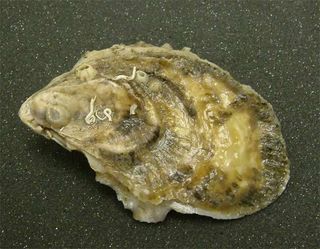Oysters' Future Imperiled as Oceans Acidify

Monterey, Calif. — Oysters, those slimy mollusks whose juices are thought to boost sexual desire, may be losing their comfy sea homes.
The reason? Global oceans are becoming more acidic as they absorb carbon dioxide pumped into the air from burning fossil fuels, which makes it difficult for calcifying organisms like oysters to create their shells.
The ocean is now 30 percent more acidic than it was before the Industrial Revolution.
At the Ocean Acidification meeting here this month, Anneliese Hettinger of UC Davis presented new research showing that Olympia oysters are smaller after being exposed, as larvae, to a high carbon-dioxide environment. The negative impacts of early exposure to carbon dioxide stuck with the juvenile oysters for at least four months into their lives, stunting their growth.
"We have to take a holistic approach when looking at the oyster instead of only focusing on one life stage," Hettinger said at the meeting.
Oyster development
The effects of acidic water on oyster development aren't uniform. The Sydney rock oyster, when exposed to high carbon-dioxide waters, grew bigger, according to a study detailed by Laura Parker of the University of West Sydney at the meeting.
Sign up for the Live Science daily newsletter now
Get the world’s most fascinating discoveries delivered straight to your inbox.
Parker and her colleagues found that while increased acidity reduced growth rates of larvae, if the oysters were exposed to more acidity during at adulthood, their larvae actually grew bigger and developed faster — possibly because the females had to invest something special in their eggs that enabled the larvae to grow bigger.
Scientific studies of larvae under different conditions are just one part of the oyster puzzle. Earlier this year, a number of hatcheries on the Oregon coast failed to produce baby oysters, and scientists were able to pin down the cause: an upwelling of deep ocean water, which is naturally more acidic than surface waters.
Oyster hatcheries
Commercial oyster production generates more than $100 million in gross sales annually on the West Coast alone, contributing around $273 million overall to the region's economy. The industry has depended since the 1970s on oyster hatcheries for a steady supply of the seed used by growers. From 2007 to 2010, major hatcheries supplying the seed — are 2-week-old oyster larvae that have yet to form shells — for West Coast oyster growers suffered persistent production failures.
Burke Hales, a chemical oceanographer at Oregon State University who looked into the upwelling, told LiveScience that while oyster hatcheries have failed in the past, the persistent failures of the past few years signaled something else was going on.
"I think it's a pretty cut-and-dried example of the oysters' system responding to ambient water carbonate chemistry," he said, referring to the fact that calcium carbonate is unavailable to shell-making creatures in acidic waters. [The Harshest Environments on Earth]
Hales' report, published in the journal Limnology and Oceanography in April, linked the production failures to the carbon dioxide levels in the water in which the larval oysters are spawned and spend the first 24 hours of their lives — the crucial time where the larvae start to swim and build shells. Hales and a colleague hope to figure out when the larvae are most sensitive to the negative impacts of acidity.
"We're zeroing in on the precise life-stage and mechanism where these organisms are sensitive. Once they make it through bottleneck, they're more robust." (The bottleneck referred to is the water's carbon dioxide level.)
The oyster industry is listening to the scientists. Bill Dewey of Taylor Shellfish Farms says the company has deployed monitoring equipment that allows it to see acidic water coming from the upwelling events and dodge it. "We pump it like crazy when we see corrosive water coming, but eventually we're not going to be able to avoid that water entirely."
Taylor primarily farms Pacific oysters, which are originally from Japan (the native Olympia Northwest oyster grows slower and smaller). Currently, they are working on breeding a more robust oyster that can continue to grow in corrosive water.
Dewey told an audience in Monterey the company is open to adjusting its operations.
"As far as looking to other species, when that time comes, we'll have to work on marketing those species," he said. "Hopefully those consumers will be flexible as well. There's going to be winners and losers out there, it's not going to be a dead ocean as the chemistry changes. We'll have to adapt what we're eating as well."
Most Popular




